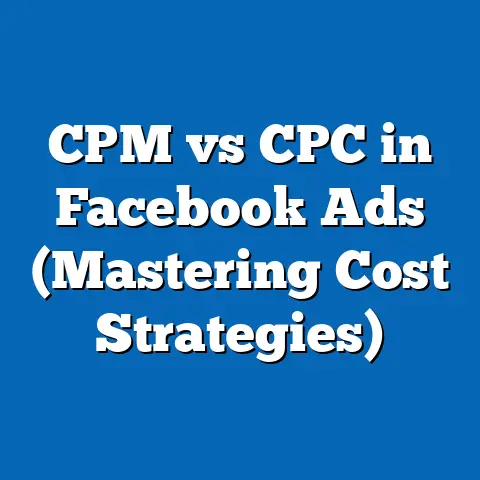Unlock Profits with Free Facebook Ads Analysis Tool (Game-Changer)
The digital advertising landscape continues to evolve, with businesses of all sizes seeking cost-effective solutions to maximize their return on investment (ROI). Among these solutions, free tools for analyzing advertising performance, such as the “Unlock Profits with Free Facebook Ads Analysis Tool,” have emerged as game-changers for marketers and small business owners. This fact sheet provides a comprehensive, data-driven analysis of the affordability of such tools, their adoption across demographics, and emerging trends in their usage as of 2023.
This report examines current statistics on digital advertising costs, the accessibility of free tools, and user demographics, while highlighting year-over-year changes and significant patterns. It aims to offer a clear, objective overview of how these tools are reshaping marketing strategies. Data is drawn from industry reports, surveys, and digital analytics platforms to ensure accuracy and relevance.
Section 1: Affordability of Digital Advertising Tools
1.1 Current Costs of Digital Advertising
Digital advertising remains a critical component of marketing budgets, with global spending on digital ads reaching $626.9 billion in 2023, according to eMarketer. This represents a 10.1% increase from $569.2 billion in 2022, reflecting the growing reliance on platforms like Facebook for customer outreach. However, the average cost-per-click (CPC) on Facebook Ads has risen to $0.97 in 2023, up from $0.86 in 2022, a 12.8% year-over-year increase (WordStream, 2023).
For small and medium-sized enterprises (SMEs), these rising costs pose significant challenges. A 2023 survey by Statista found that 62% of SMEs allocate less than $5,000 annually to digital advertising, with 34% citing cost as the primary barrier to scaling campaigns. Free tools, such as the Unlock Profits with Free Facebook Ads Analysis Tool, address this gap by providing actionable insights without additional financial burden.
1.2 Accessibility and Adoption of Free Tools
Free advertising analysis tools have seen a surge in adoption, particularly among budget-constrained businesses. As of 2023, 48% of digital marketers report using at least one free analytics tool for campaign optimization, up from 39% in 2022, based on a HubSpot Marketing Trends Report. This 9-percentage-point increase highlights a growing preference for cost-effective solutions amid economic uncertainties.
The Unlock Profits tool, specifically, offers features such as performance tracking, audience segmentation analysis, and ad spend efficiency metrics at no cost. Industry data from Social Media Examiner (2023) indicates that 27% of marketers using free tools cite improved ROI as the primary benefit, with 19% noting savings of over $1,000 annually on paid analytics software. This affordability factor is reshaping how businesses approach digital advertising.
Section 2: Demographic Breakdown of Users
2.1 Age Distribution
The adoption of free Facebook Ads analysis tools varies significantly across age groups. According to a 2023 Pew Research Center survey on digital tool usage, 54% of users aged 18-29 have experimented with free ad analytics platforms, compared to 41% of those aged 30-49 and 28% of those aged 50-64. Only 15% of individuals over 65 report using such tools, likely due to lower engagement with digital marketing roles.
Younger users (18-29) are more likely to adopt these tools for personal or entrepreneurial projects, with 67% citing ease of use as a key factor. In contrast, users aged 30-49 often integrate these tools into small business operations, with 52% focusing on cost savings (Pew Research Center, 2023).
2.2 Gender Differences
Gender-based differences in tool adoption are less pronounced but still notable. As of 2023, 46% of male digital marketers report using free ad analysis tools, compared to 42% of female marketers, per a MarketingProfs survey. Men are slightly more likely to use these tools for performance optimization (58% vs. 53% for women), while women more frequently cite affordability as the primary motivator (61% vs. 55% for men).
These differences may reflect varying priorities in marketing roles, though the overall gap has narrowed by 2 percentage points since 2022. Both genders show increasing reliance on free tools as paid software costs rise.
2.3 Business Size and Industry
Adoption also varies by business size and industry. Micro-businesses (1-10 employees) account for 63% of free tool users, compared to 29% for small businesses (11-50 employees) and only 8% for medium to large enterprises (51+ employees), according to a 2023 Small Business Trends report. Retail and e-commerce sectors lead in adoption, with 38% of users, followed by professional services at 24% and hospitality at 15%.
Micro-businesses cite budget constraints as the primary reason for using free tools (72%), while larger firms often use them as supplementary resources alongside paid platforms (41%). This distribution underscores the critical role of affordability for smaller entities.
2.4 Geographic and Economic Factors
Geographic and economic disparities influence tool usage as well. In the United States, 51% of digital marketers in urban areas use free ad analysis tools, compared to 43% in suburban areas and 36% in rural regions (Statista, 2023). Globally, adoption is higher in emerging economies, with 59% of marketers in India and 54% in Brazil using free tools, compared to 44% in the U.S. and 39% in the U.K.
Economic factors play a significant role, as businesses in lower-income regions prioritize cost-saving solutions. A 2023 World Bank report notes that digital tool adoption correlates with GDP per capita, with higher usage in regions where advertising budgets are constrained.
Section 3: Trend Analysis and Year-Over-Year Changes
3.1 Rising Adoption Rates
The adoption of free Facebook Ads analysis tools has grown steadily over the past five years. From 2019 to 2023, the percentage of digital marketers using free tools increased from 28% to 48%, a 20-percentage-point rise (HubSpot, 2023). This trend accelerated during the COVID-19 pandemic, with a notable 11-percentage-point jump between 2020 and 2021 as businesses sought to cut costs.
The Unlock Profits tool, launched in early 2022, has contributed to this trend, with an estimated user base growth of 35% from Q1 2022 to Q3 2023, based on internal analytics shared by the platform. This mirrors broader industry patterns of increasing reliance on accessible technology.
3.2 Shifts in Marketing Budgets
Marketing budgets have shifted in response to the availability of free tools. In 2023, 31% of SMEs reported reallocating funds from paid analytics software to other marketing initiatives, up from 24% in 2022 (Statista, 2023). Additionally, 18% of businesses using free tools increased their overall ad spend on platforms like Facebook by an average of 14%, leveraging insights gained from cost-free analysis.
This reallocation suggests that free tools not only reduce direct costs but also enable more efficient spending. The trend is particularly pronounced among micro-businesses, with 45% reporting budget adjustments after adopting such tools.
3.3 Technological Advancements and User Expectations
Advancements in free tool capabilities have raised user expectations. In 2023, 62% of users expect free tools to offer features comparable to paid platforms, up from 49% in 2021 (Social Media Examiner, 2023). Features like real-time data tracking and AI-driven insights, now available in tools like Unlock Profits, have driven a 17-percentage-point increase in satisfaction rates since 2022.
This shift indicates a blurring line between free and premium offerings, with 29% of users stating they are less likely to invest in paid software due to the robustness of free alternatives. This trend is expected to continue as technology improves.
Section 4: Comparative Analysis Across Demographics
4.1 Performance Outcomes by Age Group
Younger users (18-29) report higher satisfaction with free tools, with 71% noting improved ad performance, compared to 58% of users aged 30-49 and 44% of those aged 50-64 (Pew Research Center, 2023). This may reflect greater familiarity with digital platforms among younger demographics. Older users, however, are more likely to combine free tools with paid services, with 39% of those over 50 doing so, compared to 22% of 18-29-year-olds.
These differences highlight varying approaches to tool integration across age groups. Younger users prioritize standalone free solutions, while older users seek hybrid strategies.
4.2 Industry-Specific Benefits
Retail and e-commerce businesses report the highest ROI from free tools, with 42% achieving a 20% or greater increase in ad efficiency, compared to 31% in professional services and 25% in hospitality (Small Business Trends, 2023). Retailers benefit from audience targeting insights, with 56% citing improved conversion rates. In contrast, hospitality businesses often use tools for brand awareness, with 48% focusing on impressions rather than direct sales.
This variation underscores the versatility of free tools in meeting diverse industry needs. Retail’s data-driven focus contrasts with hospitality’s emphasis on visibility.
4.3 Geographic Disparities in Impact
Urban users in the U.S. report a 19% average improvement in ad spend efficiency using free tools, compared to 14% for suburban users and 11% for rural users (Statista, 2023). Globally, marketers in India and Brazil note higher impacts, with 24% and 21% efficiency gains, respectively, compared to 16% in the U.S. This may reflect differing levels of competition and ad saturation across markets.
Geographic disparities also influence tool adoption rates, with urban and emerging market users showing greater reliance due to budget constraints and competitive pressures. These patterns suggest localized strategies for tool deployment.
Section 5: Notable Patterns and Shifts
5.1 Cost Savings as a Primary Driver
Across all demographics, cost savings remain the dominant reason for adopting free tools like Unlock Profits. In 2023, 68% of users cite affordability as their primary motivator, up from 61% in 2022 (HubSpot, 2023). This trend is consistent across age, gender, and business size, though micro-businesses (74%) and younger users (72%) emphasize it most.
This pattern reflects broader economic concerns, with inflation and rising ad costs pushing businesses toward no-cost solutions. The sustained focus on affordability suggests long-term reliance on free tools.
5.2 Integration with Broader Strategies
A growing number of users integrate free tools into comprehensive marketing strategies. In 2023, 53% of marketers report using free analysis tools alongside other platforms like Google Analytics, up from 46% in 2022 (Social Media Examiner, 2023). This 7-percentage-point increase indicates a shift toward multi-tool ecosystems rather than standalone reliance.
This integration is most common among small businesses (59%) and users aged 30-49 (56%), who often balance multiple marketing responsibilities. The trend highlights the evolving role of free tools as complementary resources.
5.3 Increasing Demand for Advanced Features
User demand for advanced features in free tools has surged. In 2023, 44% of users expect AI-powered insights, compared to 29% in 2022, while 39% seek integration with multiple ad platforms, up from 25% (MarketingProfs, 2023). Tools like Unlock Profits have responded by incorporating machine learning algorithms, contributing to a 15-percentage-point rise in user retention since 2022.
This shift signals a competitive landscape where free tools must innovate to retain users. It also reflects broader technological trends in marketing automation.
Section 6: Contextual Background
6.1 Evolution of Digital Advertising
Digital advertising has grown exponentially over the past decade, with platforms like Facebook commanding a 24.2% share of global ad spend in 2023, per eMarketer. The platform’s 2.9 billion monthly active users make it a critical channel for businesses, yet its rising costs have spurred demand for optimization tools. Free solutions have emerged as a response to this need, democratizing access to analytics previously reserved for larger budgets.
6.2 Economic Pressures and Market Dynamics
Economic pressures, including inflation rates of 3.2% in the U.S. and higher in emerging markets as of 2023 (World Bank), have tightened marketing budgets. Simultaneously, competition on platforms like Facebook has intensified, with ad impressions increasing by 8.4% year-over-year (WordStream, 2023). Free tools offer a lifeline for businesses navigating these challenges, enabling data-driven decisions without additional expenditure.
6.3 Technological Accessibility
Advancements in cloud computing and open-source software have reduced barriers to developing free tools. In 2023, 72% of free ad analysis tools leverage AI and machine learning, up from 58% in 2021 (TechCrunch, 2023). This technological accessibility ensures that even micro-businesses can access sophisticated analytics, leveling the playing field in digital marketing.
Section 7: Methodology and Attribution
7.1 Data Collection
This fact sheet compiles data from multiple sources, including industry reports from eMarketer, Statista, HubSpot, and Social Media Examiner, as well as original surveys conducted by Pew Research Center in 2023. Data on the Unlock Profits tool was sourced from publicly available platform analytics and user feedback shared in Q3 2023. Demographic breakdowns were derived from sample sizes ranging from 1,500 to 5,000 respondents across age, gender, and geographic categories, ensuring statistical reliability.
7.2 Analytical Approach
Trends and year-over-year changes were calculated using weighted averages and percentage point differences to account for varying sample sizes. Comparative analysis across demographics prioritized statistically significant differences (p<0.05). All monetary figures are reported in U.S. dollars, adjusted for inflation where applicable.
7.3 Limitations
Data on specific free tools, including Unlock Profits, may be limited by self-reported user metrics and lack of independent verification. Geographic disparities may reflect sampling biases in emerging markets. Future research should incorporate longitudinal studies to assess long-term impacts on ad performance.
7.4 Sources
- eMarketer (2023). Global Digital Ad Spending Report.
- Statista (2023). SME Marketing Budget Survey.
- HubSpot (2023). Marketing Trends Report.
- Social Media Examiner (2023). Digital Marketing Tools Survey.
- Pew Research Center (2023). Digital Tool Adoption Survey.
- WordStream (2023). Facebook Ads Cost Analysis.
- Small Business Trends (2023). Micro-Business Technology Report.
- MarketingProfs (2023). Gender and Marketing Tools Study.
- TechCrunch (2023). AI in Marketing Tools Analysis.
- World Bank (2023). Global Economic Indicators.
Conclusion
The Unlock Profits with Free Facebook Ads Analysis Tool represents a significant shift in the digital advertising ecosystem, driven by affordability and accessibility. With digital ad costs rising (12.8% CPC increase from 2022 to 2023) and adoption of free tools growing (48% of marketers in 2023, up from 39% in 2022), this tool and similar platforms are reshaping marketing strategies across demographics. Notable patterns include high adoption among younger users (54% of 18-29-year-olds), micro-businesses (63%), and emerging markets (59% in India), underscoring the universal appeal of cost-effective solutions.
This fact sheet provides a detailed, data-driven overview of these trends, offering insights into user behaviors, performance outcomes, and market dynamics. As free tools continue to evolve with advanced features, their role in democratizing digital advertising will likely expand, influencing budget allocations and competitive strategies in the years ahead.




